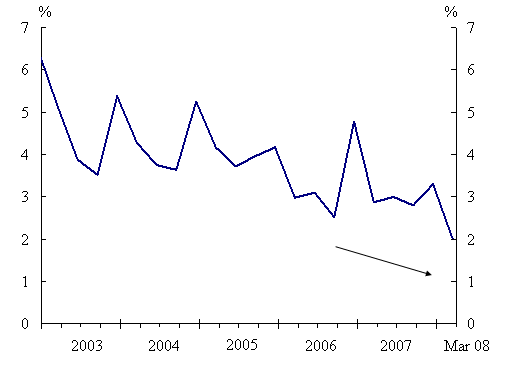The recent increases are becoming more effective in curbing commercial lending.
Readers are probably aware of the further raising of the reserve requirement ratio on the Mainland by 0.5 percentage points to 16.5%. The reserve requirement ratio has been adjusted upwards so many times since around the middle of 2006, when it was 7.5%, that I have lost count. While the upward adjustment continues to be faithfully reported by the press, it is now hardly noticed, probably even among close observers of financial market developments on the Mainland.
I am sure observers continue to see upward adjustments like this as a measure to prevent the further increases in the reserve balances of banks from encouraging the expansion of commercial credit at a time when there is some overheating in the economy and inflation is on the rise. They are absolutely right. And I am sure that when they look at the numbers, they also monitor the activities of the People's Bank of China (PBoC) in redeeming and issuing central-bank paper. A net increase in the amount of paper outstanding means a reduction in the reserve balances of banks. These operations are sometimes referred to as sterilisation, particularly when the central bank has been buying foreign currency and, in settlement of the purchases, injecting domestic currency into the banking system by crediting the clearing (or reserve) accounts of the commercial banks with the central bank.
Interestingly, it is not entirely clear how a large reserve balance held by a commercial bank with the central bank in excess of the amount dictated by the reserve requirement ratio affects the lending behaviour of the commercial bank. The reserve requirement ratio is calculated against the deposit base of the bank. So if a bank has taken deposits of RMB100 billion from customers, it is required to maintain RMB16.5 billion in its reserve account with the PBoC. In other words, the lending activities of the bank are restrained only to that extent. For a bank holding excess reserves, as long as the additional lending does not lead to an increase in its deposit base, for instance involving the borrower paying the loaned amount to the customers of other banks (which on settlement of those payments will result in a fall in the bank's reserves), the bank is all right. Even if the reserves balance becomes inadequate by reference to the reserve requirement ratio as a result of the new lending, the bank can still borrow from the inter-bank market to make it adequate, assuming that there are banks that have excess reserve balances and are willing to lend. This may explain why other measures have to be taken in parallel in order to restrain credit growth more effectively, particularly when there is ample liquidity in the banking system.
For many years banks on the Mainland collectively have maintained excess reserves, as their total reserve balances exceeded the amount required. The attached chart shows this quite clearly. But behind the recent low-key announcements of increases in the reserve requirement ratio, the excess reserves have been declining recently, particularly in March. The excess reserve ratio fell from around 6% at the beginning of 2003 to an average of 3% in 2007, and a historical low of 2% in March. I wonder whether observers of Mainland financial markets have noticed this significant change. The implication is that the upward adjustments in the reserve requirement ratio have become more effective in restraining credit expansion. In other words, these upward adjustments have actually taken on a new significance that is not apparent in the press releases. There is obviously a need to continue to observe closely to see if credit expansion indeed slows down as a result of this change, although I fear it will be hard to isolate the effects from those of the many other measures already taken.
Clearly there is a limit on how much further the reserve requirement ratio can be raised without significantly affecting the operation of the commercial banks. Transferring the excess reserves into required reserves means that the commercial banks are getting a higher return for the money, since the former earns a much lower rate of interest than the latter. But the interest rate paid on the required reserves, being a form of borrowing by the central bank from the commercial banks, is still low compared with the lending rate charged on commercial borrowers. Other things being equal, this affects the profitability of the commercial banks. Obviously, the commercial banks are still making impressive profits, given the fairly large net-interest margin they enjoy (three to four times higher than in Hong Kong), but as I have mentioned elsewhere, this is not necessarily a good thing from the macro financial-efficiency point of view.
|
Excess reserve ratio
|
 |
Note: The excess reserve ratio refers to excess reserves as a percentage of total deposits (quarterly figures).
Source: People's Bank of China
Joseph Yam
29 May 2008
Click here for previous articles in this column.
Document in Word format


